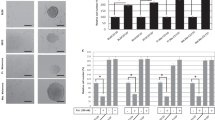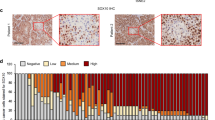Abstract
There is enormous interest to target cancer stem cells (CSCs) for clinical treatment because these cells are highly tumorigenic and resistant to chemotherapy. Oct4 is expressed by CSC-like cells in different types of cancer. However, function of Oct4 in tumor cells is unclear. In this study, we showed that expression of Oct4 gene or transmembrane delivery of Oct4 protein promoted dedifferentiation of melanoma cells to CSC-like cells. The dedifferentiated melanoma cells showed significantly decreased expression of melanocytic markers and acquired the ability to form tumor spheroids. They showed markedly increased resistance to chemotherapeutic agents and hypoxic injury. In the subcutaneous xenograft and tail vein injection assays, these cells had significantly increased tumorigenic capacity. The dedifferentiated melanoma cells acquired features associated with CSCs such as multipotent differentiation capacity and expression of melanoma CSC markers such as ABCB5 and CD271. Mechanistically, Oct4-induced dedifferentiation was associated with increased expression of endogenous Oct4, Nanog and Klf4, and global gene expression changes that enriched for transcription factors. RNAi-mediated knockdown of Oct4 in dedifferentiated cells led to diminished CSC phenotypes. Oct4 expression in melanoma was regulated by hypoxia and its expression was detected in a sub-population of melanoma cells in clinical samples. Our data indicate that Oct4 is a positive regulator of tumor dedifferentiation. The results suggest that CSC phenotype is dynamic and may be acquired through dedifferentiation. Oct4-mediated tumor cell dedifferentiation may have an important role during tumor progression.
This is a preview of subscription content, access via your institution
Access options
Subscribe to this journal
Receive 50 print issues and online access
$259.00 per year
only $5.18 per issue
Buy this article
- Purchase on Springer Link
- Instant access to full article PDF
Prices may be subject to local taxes which are calculated during checkout







Similar content being viewed by others
Accession codes
References
Bennett DC . (1983). Differentiation in mouse melanoma cells: initial reversibility and an on-off stochastic model. Cell 34: 445–453.
Ben-Porath I, Thomson MW, Carey VJ, Ge R, Bell GW, Regev A et al. (2008). An embryonic stem cell-like gene expression signature in poorly differentiated aggressive human tumors. Nat Genet 40: 499–507.
Boiko AD, Razorenova OV, van de RM, Swetter SM, Johnson DL, Ly DP et al. (2010). Human melanoma-initiating cells express neural crest nerve growth factor receptor CD271. Nature 466: 133–137.
Chan EM, Ratanasirintrawoot S, Park IH, Manos PD, Loh YH, Huo H et al. (2009). Live cell imaging distinguishes bona fide human iPS cells from partially reprogrammed cells. Nat Biotechnol 27: 1033–1037.
Chen Y, Shi L, Zhang L, Li R, Liang J, Yu W et al. (2008). The molecular mechanism governing the oncogenic potential of SOX2 in breast cancer. J Biol Chem 283: 17969–17978.
Chen Z, Xu WR, Qian H, Zhu W, Bu XF, Wang S et al. (2009). Oct4, a novel marker for human gastric cancer. J Surg Oncol 99: 414–419.
Covello KL, Kehler J, Yu H, Gordan JD, Arsham AM, Hu CJ et al. (2006). HIF-2alpha regulates Oct-4: effects of hypoxia on stem cell function, embryonic development, and tumor growth. Genes Dev 20: 557–570.
Daley GQ . (2008). Common themes of dedifferentiation in somatic cell reprogramming and cancer. Cold Spring Harb Symp Quant Biol 73: 171–174.
Gabbert H, Wagner R, Moll R, Gerharz CD . (1985). Tumor dedifferentiation: an important step in tumor invasion. Clin Exp Metastasis 3: 257–279.
Hanna J, Saha K, Pando B, van ZJ, Lengner CJ, Creyghton MP et al. (2009). Direct cell reprogramming is a stochastic process amenable to acceleration. Nature 462: 595–601.
Helczynska K, Kronblad A, Jogi A, Nilsson E, Beckman S, Landberg G et al. (2003). Hypoxia promotes a dedifferentiated phenotype in ductal breast carcinoma in situ. Cancer Res 63: 1441–1444.
Hochedlinger K, Yamada Y, Beard C, Jaenisch R . (2005). Ectopic expression of Oct-4 blocks progenitor-cell differentiation and causes dysplasia in epithelial tissues. Cell 121: 465–477.
Hu L, McArthur C, Jaffe RB . (2010). Ovarian cancer stem-like side-population cells are tumourigenic and chemoresistant. Br J Cancer 102: 1276–1283.
Hu T, Liu S, Breiter DR, Wang F, Tang Y, Sun S . (2008). Octamer 4 small interfering RNA results in cancer stem cell-like cell apoptosis. Cancer Res 68: 6533–6540.
Jogi A, Ora I, Nilsson H, Lindeheim A, Makino Y, Poellinger L et al. (2002). Hypoxia alters gene expression in human neuroblastoma cells toward an immature and neural crest-like phenotype. Proc Natl Acad Sci USA 99: 7021–7026.
Kang SK, Park JB, Cha SH . (2006). Multipotent, dedifferentiated cancer stem-like cells from brain gliomas. Stem Cells Dev 15: 423–435.
Kawamura T, Suzuki J, Wang YV, Menendez S, Morera LB, Raya A et al. (2009). Linking the p53 tumour suppressor pathway to somatic cell reprogramming. Nature 460: 1140–1144.
Kim JB, Greber B, raùzo-Bravo MJ, Meyer J, Park KI, Zaehres H et al. (2009a). Direct reprogramming of human neural stem cells by OCT4. Nature 461: 649–643.
Kim JB, Sebastiano V, Wu G, rauzo-Bravo MJ, Sasse P, Gentile L et al. (2009b). Oct4-induced pluripotency in adult neural stem cells. Cell 136: 411–419.
Kumar SM, Yu H, Edwards R, Chen L, Kazianis S, Brafford P et al. (2007). Mutant V600E BRAF increases hypoxia inducible factor-1alpha expression in melanoma. Cancer Res 67: 3177–3184.
Li W, Zhou H, Abujarour R, Zhu S, Young JJ, Lin T et al. (2009). Generation of human-induced pluripotent stem cells in the absence of exogenous Sox2. Stem Cells 27: 2992–3000.
Li Z, Rich JN . (2010). Hypoxia and hypoxia inducible factors in cancer stem cell maintenance. Curr Top Microbiol Immunol 345: 21–30.
Liu T, Xu F, Du X, Lai D, Liu T, Zhao Y et al. (2010). Establishment and characterization of multi-drug resistant, prostate carcinoma-initiating stem-like cells from human prostate cancer cell lines 22RV1. Mol Cell Biochem 340: 265–273.
Lobo NA, Shimono Y, Qian D, Clarke MF . (2007). The biology of cancer stem cells. Annu Rev Cell Dev Biol 23: 675–699.
Magnifico A, Albano L, Campaner S, Delia D, Castiglioni F, Gasparini P et al. (2009). Tumor-initiating cells of HER2-positive carcinoma cell lines express the highest oncoprotein levels and are sensitive to trastuzumab. Clin Cancer Res 15: 2010–2021.
Mani SA, Guo W, Liao MJ, Eaton EN, Ayyanan A, Zhou AY et al. (2008). The epithelial-mesenchymal transition generates cells with properties of stem cells. Cell 133: 704–715.
Masuda K, Richter M, Song X, Berezov A, Masuda K, Murali R et al. (2006). AHNP-streptavidin: a tetrameric bacterially produced antibody surrogate fusion protein against p185her2/neu. Oncogene 25: 7740–7746.
Monzani E, Facchetti F, Galmozzi E, Corsini E, Benetti A, Cavazzin C et al. (2007). Melanoma contains CD133 and ABCG2 positive cells with enhanced tumourigenic potential. Eur J Cancer 43: 935–946.
Morrison SJ, Csete M, Groves AK, Melega W, Wold B, Anderson DJ . (2000). Culture in reduced levels of oxygen promotes clonogenic sympathoadrenal differentiation by isolated neural crest stem cells. J Neurosci 20: 7370–7376.
Peng S, Maihle NJ, Huang Y . (2010). Pluripotency factors Lin28 and Oct4 identify a sub-population of stem cell-like cells in ovarian cancer. Oncogene 29: 2153–2159.
Pollard TD, Borisy GG . (2003). Cellular motility driven by assembly and disassembly of actin filaments. Cell 112: 453–465.
Quintana E, Shackleton M, Foster HR, Fullen DR, Sabel MS, Johnson TM et al. (2010). Phenotypic heterogeneity among tumorigenic melanoma cells from patients that is reversible and not hierarchically organized. Cancer Cell 18: 510–523.
Quintana E, Shackleton M, Sabel MS, Fullen DR, Johnson TM, Morrison SJ . (2008). Efficient tumour formation by single human melanoma cells. Nature 456: 593–598.
Roesch A, Fukunaga-Kalabis M, Schmidt EC, Zabierowski SE, Brafford PA, Vultur A et al. (2010). A temporarily distinct subpopulation of slow-cycling melanoma cells is required for continuous tumor growth. Cell 141: 583–594.
Saigusa S, Tanaka K, Toiyama Y, Yokoe T, Okugawa Y, Ioue Y et al. (2009). Correlation of CD133, OCT4, and SOX2 in rectal cancer and their association with distant recurrence after chemoradiotherapy. Ann Surg Oncol 16: 3488–3498.
Schatton T, Murphy GF, Frank NY, Yamaura K, Waaga-Gasser AM, Gasser M et al. (2008). Identification of cells initiating human melanomas. Nature 451: 345–349.
Schoenhals M, Kassambara A, De VJ, Hose D, Moreaux J, Klein B . (2009). Embryonic stem cell markers expression in cancers. Biochem Biophys Res Commun 383: 157–162.
Strizzi L, Abbott DE, Salomon DS, Hendrix MJ . (2008). Potential for cripto-1 in defining stem cell-like characteristics in human malignant melanoma. Cell Cycle 7: 1931–1935.
Takahashi K, Tanabe K, Ohnuki M, Narita M, Ichisaka T, Tomoda K et al. (2007). Induction of pluripotent stem cells from adult human fibroblasts by defined factors. Cell 131: 861–872.
Takahashi K, Yamanaka S . (2006). Induction of pluripotent stem cells from mouse embryonic and adult fibroblast cultures by defined factors. Cell 126: 663–676.
Viswanathan SR, Powers JT, Einhorn W, Hoshida Y, Ng TL, Toffanin S et al. (2009). Lin28 promotes transformation and is associated with advanced human malignancies. Nat Genet 41: 843–848.
Yu H, Kumar SM, Kossenkov AV, Showe L, Xu X . (2009a). Stem cells with neural crest characteristics derived from the bulge reigon of cultured human hair follicles. J Invest Dermatol 130: 1227–1236.
Yu J, Hu K, Smuga-Otto K, Tian S, Stewart R, Slukvin II et al. (2009b). Human induced pluripotent stem cells free of vector and transgene sequences. Science 324: 797–801.
Zaehres H, Lensch MW, Daheron L, Stewart SA, Itskovitz-Eldor J, Daley GQ . (2005). High-efficiency RNA interference in human embryonic stem cells. Stem Cells 3: 299–305.
Zhang X, Han B, Huang J, Zheng B, Geng Q, Aziz F et al. (2010). Prognostic significance of OCT4 expression in adenocarcinoma of the lung. Jpn J Clin Oncol 40: 961–966.
Zhou H, Wu S, Joo JY, Zhu S, Han DW, Lin T et al (2009). Generation of induced pluripotent stem cells using recombinant proteins. Cell Stem Cell 4: 381–384.
Acknowledgements
We thank Dr M Herlyn (The Wistar Institute) for providing the melanoma cell lines; Dr GQ Daley (Harvard) for providing shRNA to Oct4; Dr W Lee (University of Pennsylvania) for suggestions to the manuscript; the histology laboratory at the Department of Pathology and Laboratory Medicine for assistance in histological studies; and Drs K Huang and JS Martin for manuscript editing. This work was supported by the grants AR-054593, CA-116103 and CA-093372 from National Institute of Health to XX.
Author information
Authors and Affiliations
Corresponding author
Ethics declarations
Competing interests
The authors declare no conflict of interest.
Additional information
Supplementary Information accompanies the paper on the Oncogene website
Supplementary information
Rights and permissions
About this article
Cite this article
Kumar, S., Liu, S., Lu, H. et al. Acquired cancer stem cell phenotypes through Oct4-mediated dedifferentiation. Oncogene 31, 4898–4911 (2012). https://doi.org/10.1038/onc.2011.656
Received:
Revised:
Accepted:
Published:
Issue Date:
DOI: https://doi.org/10.1038/onc.2011.656
Keywords
This article is cited by
-
Regulation and signaling pathways in cancer stem cells: implications for targeted therapy for cancer
Molecular Cancer (2023)
-
POU5F1 promotes the proliferation, migration, and invasion of gastric cancer cells by reducing the ubiquitination level of TRAF6
Cell Death & Disease (2023)
-
The role of transposable elements in aging and cancer
Biogerontology (2023)
-
3D and organoid culture in research: physiology, hereditary genetic diseases and cancer
Cell & Bioscience (2022)
-
Activating transcription factor 5 (ATF5) promotes tumorigenic capability and activates the Wnt/b-catenin pathway in bladder cancer
Cancer Cell International (2021)



